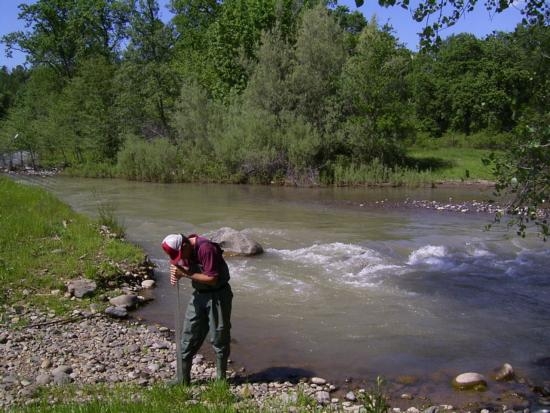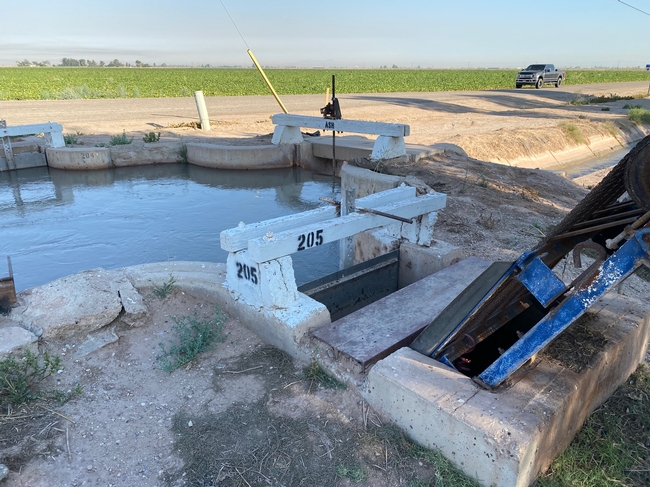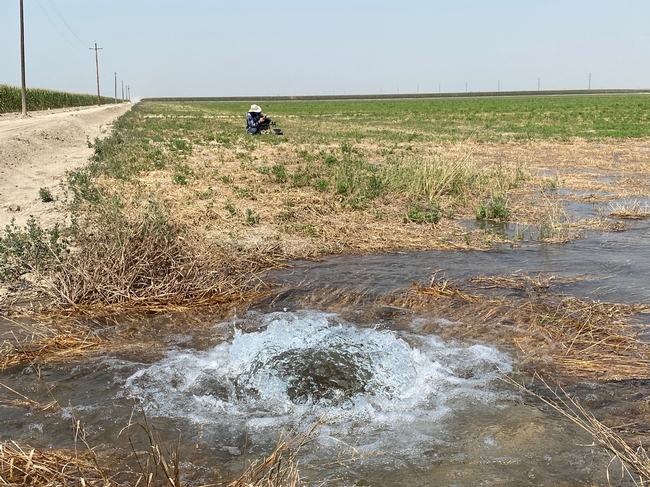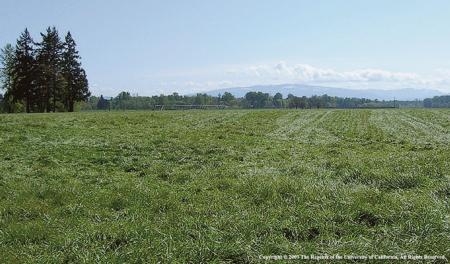Posts Tagged: Larry Forero
Water measurement and reporting course offered by UCCE May 20
Learning from the University of California Cooperative Extension how to correctly install and maintain a water volume measurement system on his ranch has saved Modoc County rancher Glenn Nader a significant amount of money.
Nader, a retired UC Cooperative Extension advisor himself, and his wife have owned and operated a 2,880-acre ranch in Modoc County since 1999.
“We divert irrigation water out of the creeks on the ranch for irrigation of the cattle pastures and hay fields,” Nader said. “The State of California required that we hire a certified engineer to set up and maintain water measurement devices at three locations on the ranch. Because of our remote location, the cost of an engineer would have been over $4,000 for set up alone.”
“After the class, I was confident that we could meet the state standards and that I could implement a water measurement system on our ranch.”
After Senate Bill 88 became law in 2015, California water-rights holders who have diverted or intend to divert more than 10 acre-feet per year or who are authorized to divert that amount of water have been required to measure and report the water they divert from surface streams. For people who wish to take the water measurements themselves, state law allows UC Cooperative Extension training to receive certification.
A virtual training is scheduled for May 20, 2021, beginning at 1 p.m. and concluding at 4 p.m. Registration is $25 and includes downloadable course materials. Register at https://ucanr.edu/survey/survey.cfm?surveynumber=33616.
At the workshop, participants can expect to:
- clarify reporting requirements for ranches
- understand what meters are appropriate for different situations
- learn how to determine measurement equipment accuracy
- develop an understanding of measurement weirs
- learn how to calculate and report volume from flow data
“There will be a limited number of water measurement trainings offered in 2021,” said Larry Forero, instructor and UC Cooperative Extension livestock and natural resources advisor. “If you need this training, register soon.”
If you have any questions about this training, please contact Forero at lcforero@ucanr.edu or Sara Jaimes at sbjaimes@ucanr.edu or by calling the UCCE office in Shasta County at (530) 224-4900. For additional information about AB 589, which called for this training, please visit https://ucanr.edu/sites/AB589.
Background:
Senate Bill 88 requires that all water right holders who have previously diverted or intend to divert more than 10 acre-feet per year (riparian and pre-1914 claims), or who are authorized to divert more than 10 acre-feet per year under a permit, license, or registration, to measure and report the water they divert.
Detailed information on the regulatory requirements for measurement and reporting is available on the State Water Resources Control Board Reporting and Measurement Regulation webpage. The legislation as written requires for diversion (or storage) greater than or equal to 100-acre feet annually that installation and certification of measurement methods be approved by an engineer/contractor/professional.
The California Cattlemen's Association worked with Assemblyman Frank Bigelow to introduce a bill that would allow a self-certification option. Assembly Bill 589 became law on Jan. 1, 2018. This bill, until Jan. 1, 2023, allows any diverter, as defined, “who has completed this instructional course on measurement devices and methods administered by the University of California Cooperative Extension,” including passage of a proficiency test, to be considered a qualified individual when installing and maintaining devices or implementing methods of measurement. The bill required UC Cooperative Extension and the board to jointly develop the curriculum for the course and the proficiency test.
UCCE's Larry Forero is helping ranchers cope with drought
The California drought is helping UC Cooperative Extension advisor Larry Forero focus his outreach program. Forero is working closely with livestock producers to help them maximize the benefit they get from the water they have available, according to a profile of the farm advisor written by Tim Hearden and published in Capital Press.
The story said Forero is working with a rancher in eastern Shasta County to measure the efficiency of well water on irrigated pasture. He plans to share results with other ranchers at "irrigation school" in January. (Date and location TBA at http://ceshasta.ucanr.edu.)
“If they're over-irrigating in September or October, could we do something different with that water?” Forero said. “What we're hoping with this irrigation school is to get this real-time data out there and share it with participants so they can look at what alternatives they might develop with irrigation scheduling.”
Forero is well-positioned to help with new regulations that will likely come down now that Gov. Brown has signed legislation that will give the state water board broad control over groundwater in California. Forero has experience helping farmers comply with new regulations.
In 2012, when local farmers with surface water rights had to begin submitting precise monthly water-use records, Forero and his colleague UCCE advisor Allan Fulton wrote a paper that explained how to measure surface water diversion.
"What we really tried to do," Forero said, "is make it so it wasn't so overwhelming that people said, 'I don't have time to do this.' From a Cooperative Extension perspective, we don't buy, sell or regulate. We try to provide ideas for folks, and what they do with them is up to them.”
It's raining in California, but drought concerns haven't been quenched
A storm is dropping some much-needed moisture in California today, but the drought drags on. Using UC sources, the media has been reporting on the effect of a prolonged rainless period this winter and well-below-average rainfall the last three years.
A story in the Los Angeles Times this week opened with the concerns of cattle ranchers. Without winter rain rangeland grass doesn't grow. Ranchers must decide whether to buy expensive feed or cull their herds to weather the drought.
"Their struggle is a bellwether for California's $45 billion agriculture sector," wrote reporter David Pierson. The repercussions will be felt beyond the state's borders. "The Golden State produces nearly half of all U.S.-grown fruits, nuts and vegetables and is the nation's leading dairy and wine producer."
Pierson quoted Doug Parker, director of the UC California Institute for Water Resources, in his article.
"The agriculture industry is definitely hit the hardest by drought," Parker said. "In California, agriculture uses 80 percent of water in the state. It's a major input for their business and hits their finances and employment directly."
The San Luis Obispo Tribune reported on drought hardships for SLO County fruit and vegetable farmers. Growers are facing increasing irrigation costs and taking steps to reduce salt buildup in the soil.
"The drought forces growers to prioritize crop cycles,” said Mary Bianchi, UC Cooperative Extension adviser. “What do you plant, and what do you leave fallow?”
In Stanislaus County, ranchers are expressing concerns about a trend among farmers toward planting almonds, reported the The Modesto Bee. Ranchers are worried the spread of almonds, walnuts an other high-value crops could strain their limited groundwater, drive up land prices and intrude on their way of life.
“It's not hard to understand why (farmers are planting more almonds),” said Roger Duncan, UCCE advisor. “It's very profitable.”
It was Duncan who provided the rough figures on almond profitability during the first day of the ninth annual summit of the California rangeland Conservation Coalition recently, wrote Bee reporter John Holland. Duncan said the net is even better for walnuts, which are not as extensive but still have had major growth in acreage. He also said the nut boom could be limited by a shortage of water and land.
The Drovers Cattle Network reported that cattle ranchers are seeking strategies for surviving the drought.
According to the article, rancher Billy McDonald's wife, Aileen, said she learned from UC Cooperative Extension farm advisor Glenn Nader that "you need to set a date, like if it doesn't rain by a certain date, to start culling. That's really important."
Also as part of the story, Roger Ingram, UCCE advisor in Placer and Nevada counties, advised ranchers to develop a drought plan.
Ingram warned against overgrazing and emphasized the importance of leaving enough residual dry matter in the ground to enhance seed germination and minimize soil erosion. With more bare ground, water would run off instead of soaking in, he said, and there would be less organic matter to feed soil microbes, resulting in fields being overrun by undesirable plants such as medusahead and yellow starthistle.
"Your grazing strategy should be take half, leave half," he said.
For those who are on irrigated pasture with limited water supply, UCCE advisor Larry Forero said fields are the driest in the summer but can get by with less water in the fall, so irrigate as close to evapotranspiration as possible and then stop irrigating. He also advised leaving four to five inches of stubble to facilitate pasture growth in the fall, should it rain or irrigation water become available.
UCCE plans meeting to help producers with new water rules
Farmers and ranchers who use river or stream water must start submitting precise monthly records to the California Water Quality Control Board this year, said an article by Tim Hearden in Capital Press.
Before the new law took effect, the water board asked landowners for estimates, said Allan Fulton, a University of California Cooperative Extension advisor who serves Colusa, Glenn and Shasta counties. Fulton is an irrigation and water resources expert.
"There is a statewide effort at trying to more precisely understand and quantify how water is being used," he said.
UC Cooperative Extension will host a workshop March 31 to discuss the new requirement.
"I've had enough questions that I thought we ought to organize something," said Larry Forero, a UCCE director and advisor in Trinity County who specializes in livestock and natural resources.
Agritourism generates income, promotes farms
Tim Hearden, Capital Press
Agritourism, or activities and products offered on working farms to generate extra income from visitors, is a growing movement in California.
A recent UC survey determined that about 2.4 million visitors came to California farms in 2008 to enjoy some facet of agritourism, which could include lodges and cabins, pumpkin patches, corn mazes, "U-pick" operations and special events such as weddings and conferences.
"I think it really does help" farms, said UC agritourism coordinator Penny Leff. "It helps their name recognition if they're selling at the farmers' market or local stores. It helps in general for people to understand what farming's about, that food comes from farms."
Redding newspaper article features new Shasta CD
The Redding Record Searchlight ran a story last week introducing Shasta County residents to their new UC Cooperative Extension director, Larry Forero. Forero replaces Gary Nakamura, who retired in June after 27 years as a forestry specialist - the last four he also served as county director.
The story noted that Forero, 50, has been the UCCE livestock/natural resources advisor in Shasta County for 20 years and will continue in that role in addition to his county director duties. Forero grew up in Weaverville and earned a bachelor's degree in agriculture from Chico State University, a master's degree in range science from Colorado State University and a doctorate in wildland resource science from UC Berkeley.
Forero told reporter Laura Christman that he isn't planning big changes for the local Cooperative Extension service. He expects his biggest challenge to be the tough economic times.
"Like every government entity at this instant, we are trying to figure out what the state budget is and how that is going to play back out in the counties," Forero was quoted in the story.
There are three advisers — livestock/natural resources, nutrition/family/consumer science and crop science — serving Shasta and Trinity counties. Nakamura's forestry specialist position is not expected to be refilled.
With a smaller staff, Cooperative Extension has had to change its approach, Forero said.
"We are doing a lot of webinars and online workshops to compensate for reduced support for face-to-face workshops and field meetings," he was quoted.

Larry Forero checks water transparency of Cow Creek. Photo by Lisa Thompson.






